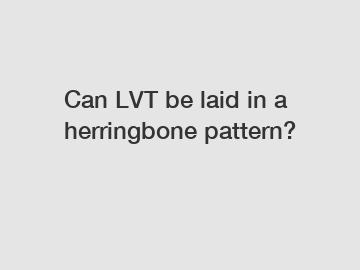Feb. 08, 2024
Construction
Can LVT be Laid in a Herringbone Pattern?
Luxury Vinyl Tile (LVT) is becoming increasingly popular as a flooring option for both residential and commercial spaces. It offers durability, affordability, and versatility, with a wide range of design options to suit any interior aesthetic. One popular question that arises when considering LVT is whether it can be laid in a herringbone pattern. In this article, we will explore the possibilities and considerations of laying LVT in a herringbone pattern.
What is a Herringbone Pattern?

A herringbone pattern is a distinctive arrangement of rectangular or parallelogram tiles to create a zigzag pattern. The tiles are laid at 45-degree angles to form a continuous V-shaped pattern. Traditionally, herringbone patterns were made using hardwood, but LVT has gained popularity as a more affordable and practical alternative.
The Advantages of Laying LVT in a Herringbone Pattern.
LVT offers several advantages when considering a herringbone pattern. Firstly, it allows for greater design versatility, as LVT is available in a wide range of colors, textures, and patterns. This allows homeowners and designers to achieve their desired aesthetic while still benefiting from the durability and cost-effectiveness of LVT.
Additionally, LVT is a highly durable material that can withstand heavy foot traffic, making it suitable for both residential and commercial applications. By laying LVT in a herringbone pattern, the rigidity and stability of the interlocking tiles further enhance its durability, ensuring a long-lasting flooring solution.
Considerations for Laying LVT in a Herringbone Pattern.
While laying LVT in a herringbone pattern may seem like a straightforward process, there are a few considerations to keep in mind. Firstly, it is essential to ensure that the subfloor is level and smooth to achieve a seamless and uniform herringbone pattern. Any imperfections in the subfloor can affect the overall appearance and performance of the LVT.
It is also crucial to use high-quality adhesive specifically designed for use with LVT. The adhesive should provide strong bonding, flexibility, and resistance to moisture. Additionally, the installer should follow the manufacturer's guidelines for laying LVT in a herringbone pattern, as incorrect installation can lead to issues such as buckling or gaps between the tiles.
Finally, it is recommended to hire a professional flooring installer with experience in laying LVT in a herringbone pattern. They can ensure a precise installation, proper alignment, and minimize the risk of any complications.
Conclusion.
In conclusion, LVT can indeed be laid in a herringbone pattern. It offers several advantages, such as design versatility, durability, and cost-effectiveness. However, certain considerations need to be taken into account, such as the condition of the subfloor, the use of high-quality adhesive, and the importance of professional installation. By following these guidelines, homeowners and designers can achieve a beautiful herringbone pattern using LVT.
For more information on laying LVT in a herringbone pattern or to explore other flooring options, please contact us. Our team of experts is ready to assist you in finding the perfect flooring solution for your space.
If you are looking for more details, kindly visit spc flooring turkey, is spc flooring environmentally friendly, WPC Flooring manufacturer.
Previous: What are the 5 major types of valves?
Next: Revolutionizing Underground Piping: Which Wrapping Tape Shines?
If you are interested in sending in a Guest Blogger Submission,welcome to write for us!
All Comments ( 0 )